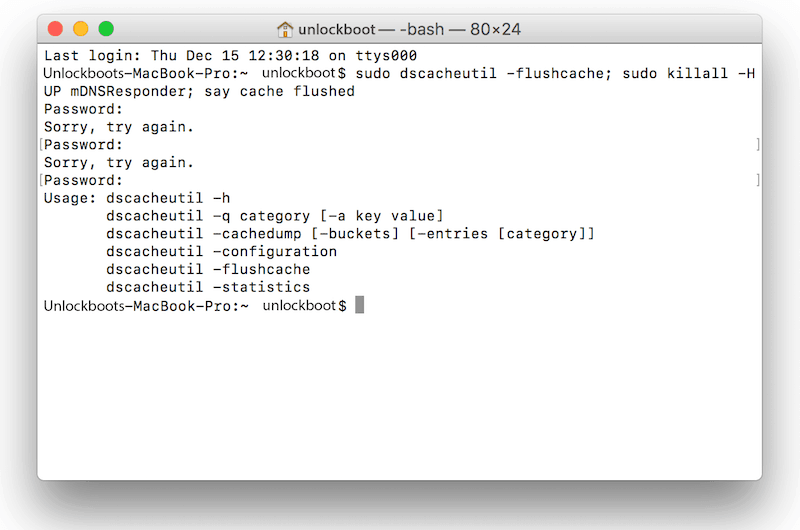

This tool enables users to quickly check the resolution on DNS records (such as the CDN CNAME) from multiple geographical locations.
#FLUSH DNS FOR MAC SIERRA FREE#
We then ran the client’s CDN URL through the free whatsmydns tool. The first thing we did was ping the CDN subdomain to see if we could access it. Upon inspecting their site with Chrome Devtools, we could see that everything coming from their CDN subdomain ( ) wasn’t loading correctly, and instead was reporting 404 errors. The site appeared to be loading just fine for us, however, and the client hadn’t made any recent changes. The client reached out to us because their images, CSS, and JavaScript weren’t loading correctly on their website. To illustrate the point further, let’s look at an example that actually happened to a Kinsta client’s website. In any of these situations, clearing your DNS cache can often help you resolve the problem and get back online. It can also simply become outdated or create internet connectivity issues.

Unfortunately, your DNS cache may become corrupted, leading you into phishing schemes. This enables your browser to reload sites you’ve visited in the past more quickly than if it had to reference the DNS again each time. So, DNS caching involves your Operating System (OS) or browser capturing recently-visited IP addresses and saving them in a database. As for ‘caching’, it’s the process of saving a snapshot of something (such as a web page) so it can be reloaded faster in the future. You can think of it as a directory or phone book for websites. You can also just do all of this in System Preferences, but the shell script is faster and is basically instant.In order to understand why you may need to flush your DNS cache, there are several components we need to break down.įirst, the Domain Name System (DNS) is an index of all the websites on the internet and their IP addresses. The setdnsservers subcommand expects the list of DNS servers to be space separated. The last line restores your original DNS servers.

You can confirm that it is actually cleared using klanomath's technique. This triggers the DNS cache to be cleared. Next, we change the DNS server to an obviously fake one. The if statement handles the special case of where your DNS servers have been handed down via DHCP. As the getdnsservers subcommand returns one DNS server per line, we use tr (transform) to change the newlines into spaces. The second line gets your currently set DNS Servers. Set your network service name in the first line. Networksetup -setdnsservers $NETWORKSVC $DNSSERVERS Networksetup -setdnsservers $NETWORKSVC 0.1.2.3 NETWORKSVC="Wi-Fi"ĭNSSERVERS=`networksetup -getdnsservers $NETWORKSVC | tr '\n' ' '` Here's the shell script I use to help automate this. I've discovered an alternate way to clear the DNS cache, and you don't need any root permissions. To get the results above open Console.app, choose your hostname in "Devices" and use a filter mDNSResponder & Cache size: This can easily be tested with the following command sequence: sudo killall -INFO mDNSResponderĭefault 03:54:55.672826 +0200 mDNSResponder Cache size 282 entities 189 in use (73 group, 29 multicast, 87 unicast) 2 referenced by active questionsĭefault 03:54:55.694219 +0200 mDNSResponder Unicast Cache size 1769 sudo dscacheutil -flushcacheĭefault 03:55:52.148629 +0200 mDNSResponder Cache size 282 entities 180 in use (79 group, 19 multicast, 82 unicast) 2 referenced by active questionsĭefault 03:55:52.157180 +0200 mDNSResponder Unicast Cache size 1992 sudo killall -HUP mDNSResponderĭefault 03:56:39.446829 +0200 mDNSResponder Cache size 282 entities 8 in use (4 group, 0 multicast, 4 unicast) 2 referenced by active questionsĭefault 03:56:39.466259 +0200 mDNSResponder Unicast Cache size 121 Sudo killall -HUP mDNSResponder sends a hang up to mDNSResponder, launchd will restart the daemon and the DNS cache will be cleared as spillover effect. Sudo dscacheutil -flushcache does nothing useful related to DNS cache entries - at least in non-LDAP environments and 10.9-10.13.


 0 kommentar(er)
0 kommentar(er)
